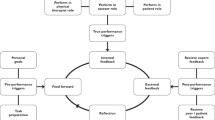Abstract
Emerging technologies and student information technology literacy are enabling new methods of teaching and learning for clinical skill performance. Facilitating experiential practice and reflection on performance through student self-video, and exposure to peer benchmarks, may promote greater levels of skill competency. This study examines the impact of student self-video on the attainment of clinical skills. A total of 60 Physiotherapy students (100%) consented to participate in the randomised controlled trial. One group (50%) was taught a complex clinical skill with regular practical tutoring, whilst the other group (50%) supplemented the tutoring with a self-video task aimed at promoting reflection on performance. Student skill performance was measured in an objective structured clinical examination (OSCE). Students also completed an anonymous questionnaire, which explored their perception of their learning experiences. Students received significantly higher scores in the OSCE when the examined clinical skill had been supplemented with a self-video of performance task (P = 0.048). Descriptive analysis of the questionnaires relating to student perceptions on the teaching methods identified that the self-video of performance task utilised contributed to improvement in their clinical performance and their confidence for future clinical practice. Students identified a number of aspects of the submission process that contributed to this perception of educational value. The novel results of this study demonstrate that greater clinical skill competency is achieved when traditional tutoring methods are supplemented with student self-video of performance tasks. Additional benefits included the ability of staff and students to monitor longitudinal performance, and an increase in feedback opportunities.


Similar content being viewed by others
References
Aspegren, K. (1999). BEME guide No. 2: Teaching and learning communication skills in medicine—a review with quality grading of articles. Medical Teacher, 21, 563–570.
Barker, S. P. (1988). Comparison of effectiveness of interactive videodisc versus lecture-demonstration instruction. Physical Therapy, 68, 699–703.
Biggs, J. (1999). What the student does: Teaching for enhanced learning. Higher Education Research and Development, 18, 57–75.
Boyer, E., Miltenberger, R. G., Batsche, C., & Fogel, V. (2009). Video modeling by experts with video feedback to enhance gymnastics skills. Journal of Applied Behavior Analysis, 42, 855–860.
Coffee, J. (2007). Using an on line audio visual aid to facilitate the teaching and learning of clinical reasoning. Focus on Health Professional Education, 9, 89–91.
Coffee, J., & Hillier, S. (2008). Teaching pre-cursor clinical skills using an online audio-visual tool: An evaluation using student responses. Journal of Online Learning and Teaching, 4, 469–476.
Davis, D., O’Brien, M. A., Freemantle, N., Wolf, F. M., Mazmanian, P., & Taylor-Vaisey, A. (1999). Impact of formal continuing medical education: Do conferences, workshops, rounds, and other traditional continuing education activities change physician behavior or health care outcomes? JAMA, 282, 867–874.
Donaghy, M., & Morss, K. (2007). An evaluation of a framework for facilitating and assessing physiotherapy students’ reflection on practice. Physiotherapy Theory & Practice, 23, 83–94.
Emmen, H., Wesseling, L., Bootsma, R., Whiting, H., & van Wieringen, P. (1985). The effect of video-modelling and video-feedback on the learning of the tennis service by novices. Journal of Sports Science, 3, 127–138.
George, J. H., & Doto, F. X. (2001). A simple five-step method for teaching clinical skills. Family Medicine, 33, 577–578.
Gordon, M. J. (1991). A review of the validity and accuracy of self-assessments in health professions training. Academic Medicine, 66, 762–769.
Grimshaw, J. M., Shirran, L., Thomas, R., Mowatt, G., Fraser, C., Bero, L., Grilli, R., Harvey, E., Oxman, A., & O’brien, M. A. (2001). Changing provider behavior: An overview of systematic reviews of interventions. Medical Care, 39, II2-45.
Hewson, M. G., & Little, M. L. (1998). Giving feedback in medical education: Verification of recommended techniques. Journal of General Internal Medicine, 13, 111–116.
Hill, J. (2002). Overcoming obstacles and creating connections: Community building in web-based learning environments. Journal of Computing in Higher Education, 14, 67–86.
Kruger, J., & Dunning, D. (1999). Unskilled and unaware of it: How difficulties in recognizing one’s own incompetence lead to inflated self-assessments. Journal of Personality and Social Psychology, 77, 1121–1134.
Mayer, R. E. (2003). The promise of multimedia learning: using the same instructional design methods across different media. Learning and Instruction, 13(2), 125–139.
Noordman, J., Verhaak, P., & van Dulmen, S. (2011). Web-enabled video-feedback: A method to reflect on the communication skills of experienced physicians. Patient Education and Counseling, 82, 335–340.
Oblinger, D. (2006). Space as a change agent., Washington DC, Boulder CO, Educause.
Salyers, V. L. (2007). Teaching psychomotor skills to beginning nursing students using a web-enhanced approach: A quasi-experimental study. International Journal of Nursing Education Scholarship, 4, Article11.
Schwan, S., & Riempp, R. (2004). The cognitive benefits of interactive videos: Learning to tie nautical knots. Learning and Instruction, 14(3), 293–305.
Shepard, K., & Jensen, G. (2002). Handbook of teaching for physical therapists. Boston: Butterworth Heineman.
Author information
Authors and Affiliations
Corresponding author
Rights and permissions
About this article
Cite this article
Maloney, S., Storr, M., Morgan, P. et al. The effect of student self-video of performance on clinical skill competency: a randomised controlled trial. Adv in Health Sci Educ 18, 81–89 (2013). https://doi.org/10.1007/s10459-012-9356-1
Received:
Accepted:
Published:
Issue Date:
DOI: https://doi.org/10.1007/s10459-012-9356-1




